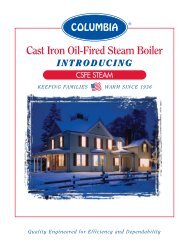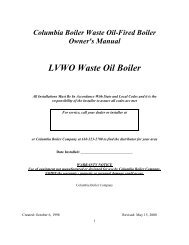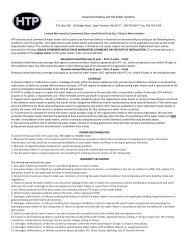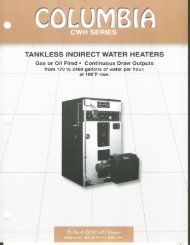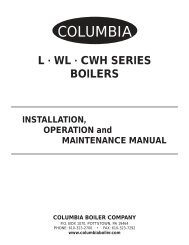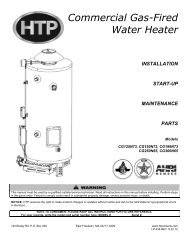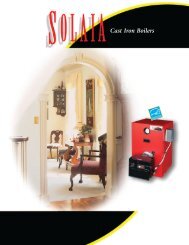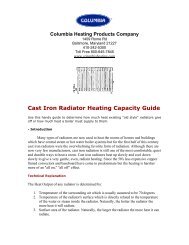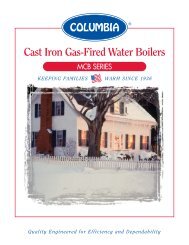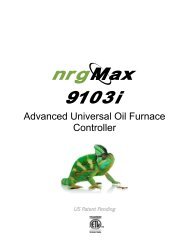MPH Manual - Columbia Heating
MPH Manual - Columbia Heating
MPH Manual - Columbia Heating
You also want an ePaper? Increase the reach of your titles
YUMPU automatically turns print PDFs into web optimized ePapers that Google loves.
Hot Water Connections<br />
Use the fittings located on either side in the lower front of the boiler for the hot water return<br />
from the system. Hot water applications also require the use of an expansion tank in the system<br />
piping, to compensate for fluctuations in the water volume during heating and cooling cycles.<br />
NOTE: Do not use lower rear fittings for returns.<br />
Feed Water Supply<br />
Virtually any unused port on the heat exchanger can be used for the feed water supply. In situations<br />
where make up water is needed, the water supply must be treated before it enters the<br />
boiler to prevent the formation of scale, and to protect the boiler surfaces from the corrosive<br />
effects of oxygenated water. Water treatment and a water treatment program must be adhered<br />
to, or the life of the boiler will be effected. If a Condensate Return / Feedwater Tank is used,<br />
connect the feedwater source to the float valve on the tank. Return to the section on water treatment<br />
later in this manual.<br />
Boilers with Coils<br />
When ordered with coils, boilers are shipped with the coil(s) assembled to the coil plate(s), and<br />
mounted in the boiler. <strong>MPH</strong> boilers 30 thru 80 HP can be furnished with one or two coils.<br />
When making coil connections for twin coil units, manifold indirect water piping using copper<br />
tubing and fittings connected in parallel. Pipe the outside coil openings together for cold water<br />
inlets, and the inside coil openings for hot water outlets. If necessary, temper the hot water supply<br />
by using a mixing valve. Connect the hot water outlet source and a cold water supply line to<br />
a mixing valve, to temper the hot water supply to the proper temperature requirements for<br />
process equipment.<br />
Whenever boilers are supplied with one or two coils, the coils must be covered by a minimum<br />
of two inches of water, during normal operation, to allow proper heat transfer through the coil.<br />
Adjust all LWCO piping to keep the coil(s) submerged in the event of a low water situation.<br />
FUEL CONNECTIONS<br />
OIL SUPPLY PIPING<br />
Connect burner to oil supply. Refer to fuel unit manufacturer literature for piping, connections,<br />
lift and tank installation. If such information is unavailable use the following guidelines:<br />
Fuel supply “level with” or “above” burner: A single stage fuel unit connected to the fuel supply<br />
with a single supply line is the most common type of installation for these conditions. <strong>Manual</strong><br />
venting of the fuel oil is usually required on initial start up. Failure to vent air could result in<br />
air lock/oil starvation.(One Pipe)<br />
Fuel supply below the level of the burner: Use a single stage fuel pump in lift conditions of<br />
up to 10 feet and a two stage pump when lift exceeds 10 feet. Both conditions require the use<br />
of a return line which purges the fuel pump of air, returning it to the fuel tank. The “by-pass” plug<br />
must be inserted into the fuel pump when installing a return line. (Two Pipe)<br />
9<br />
<strong>MPH</strong> COLUMBIA BOILER COMPANY



